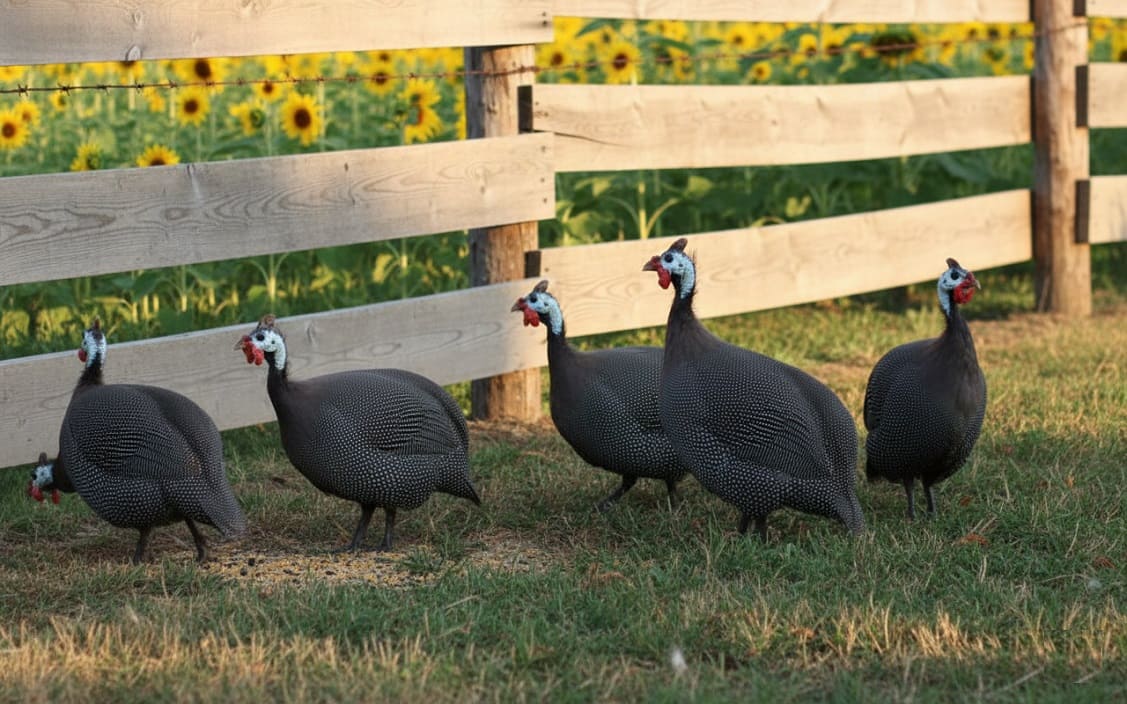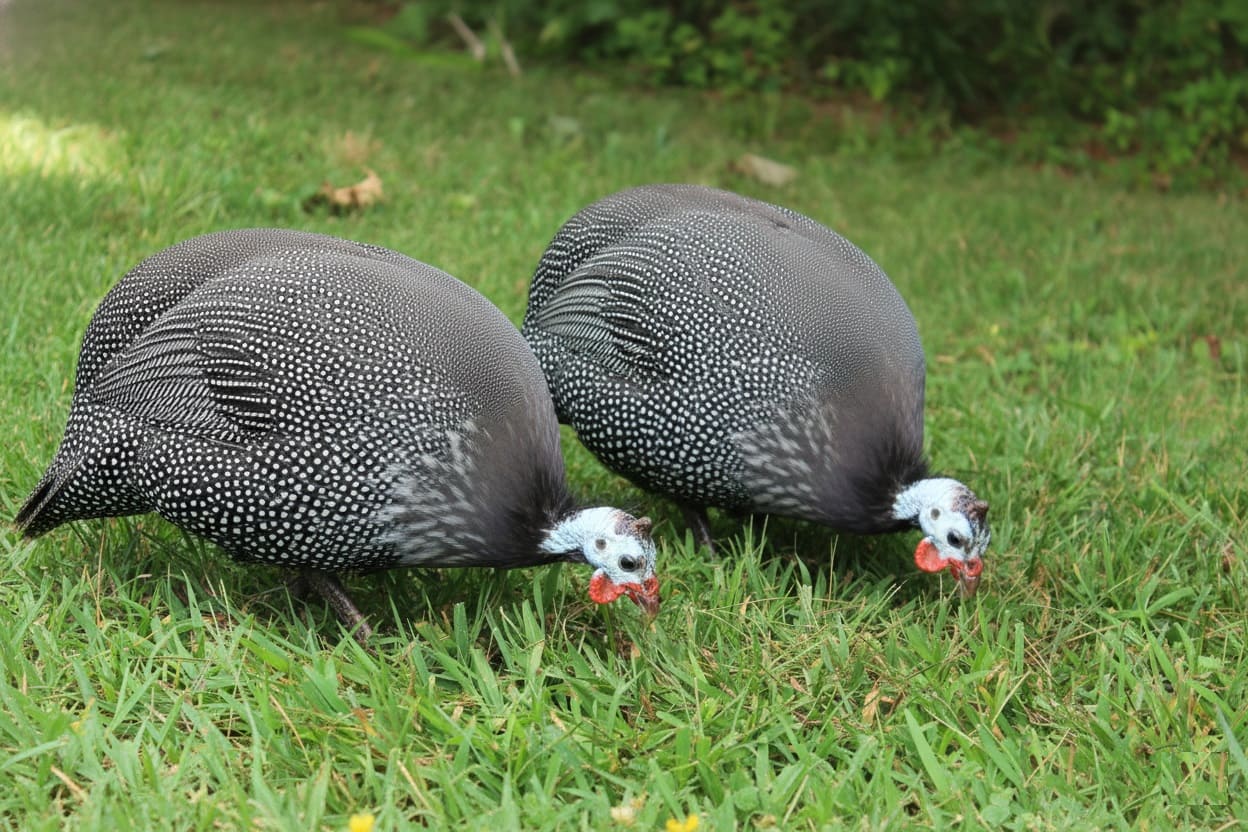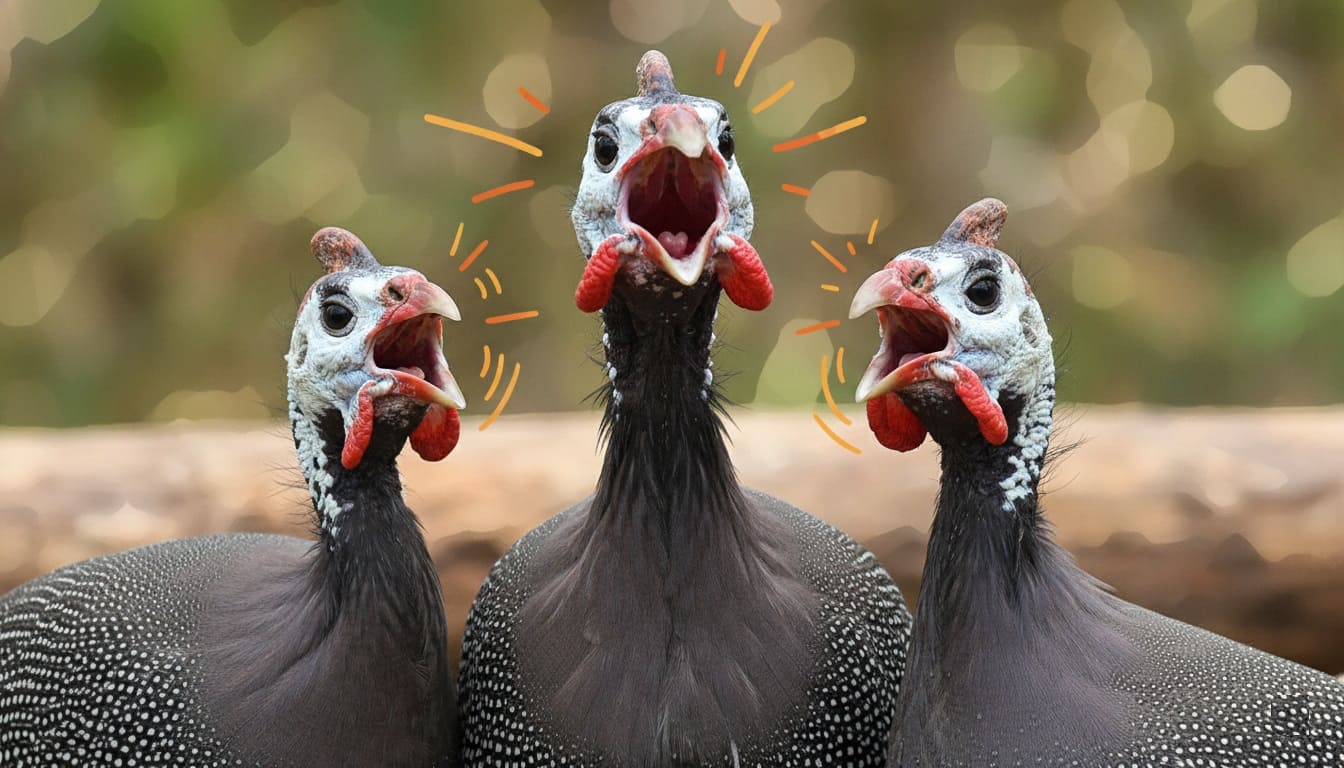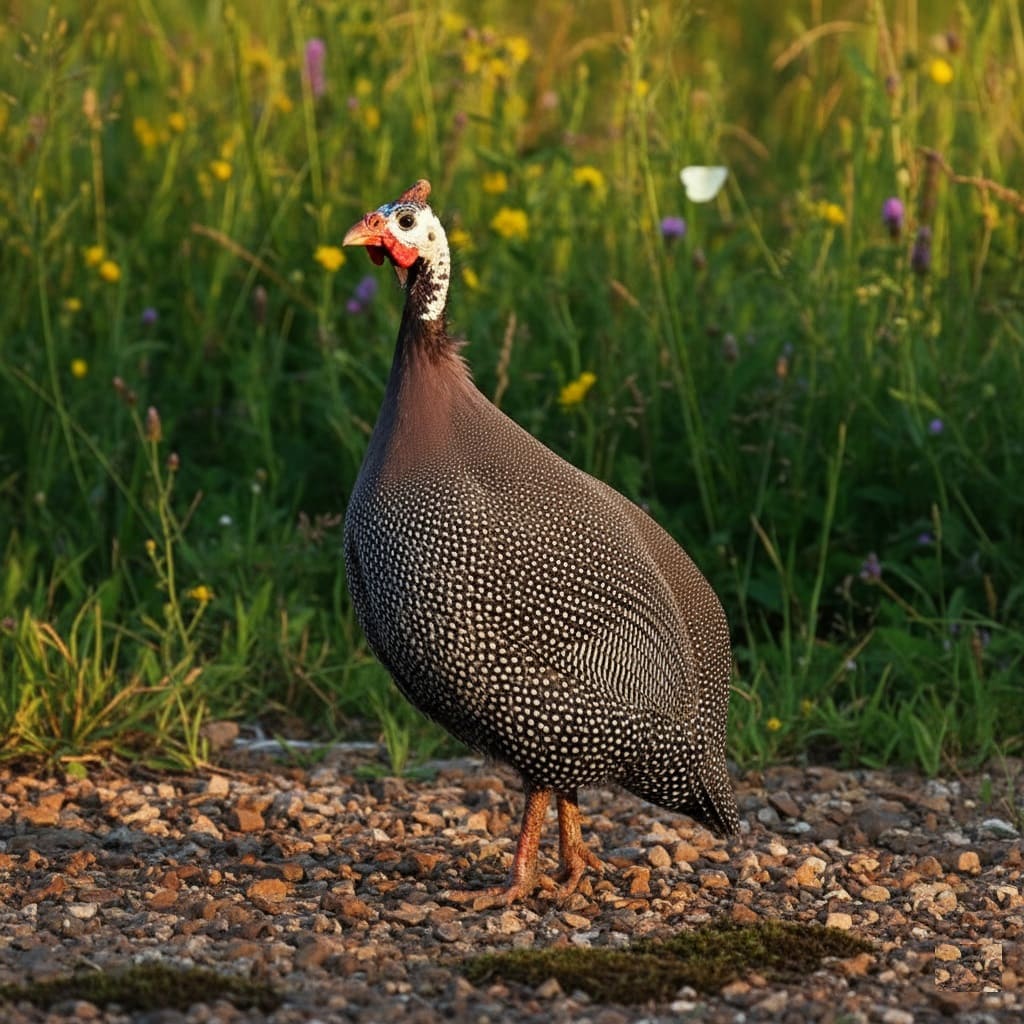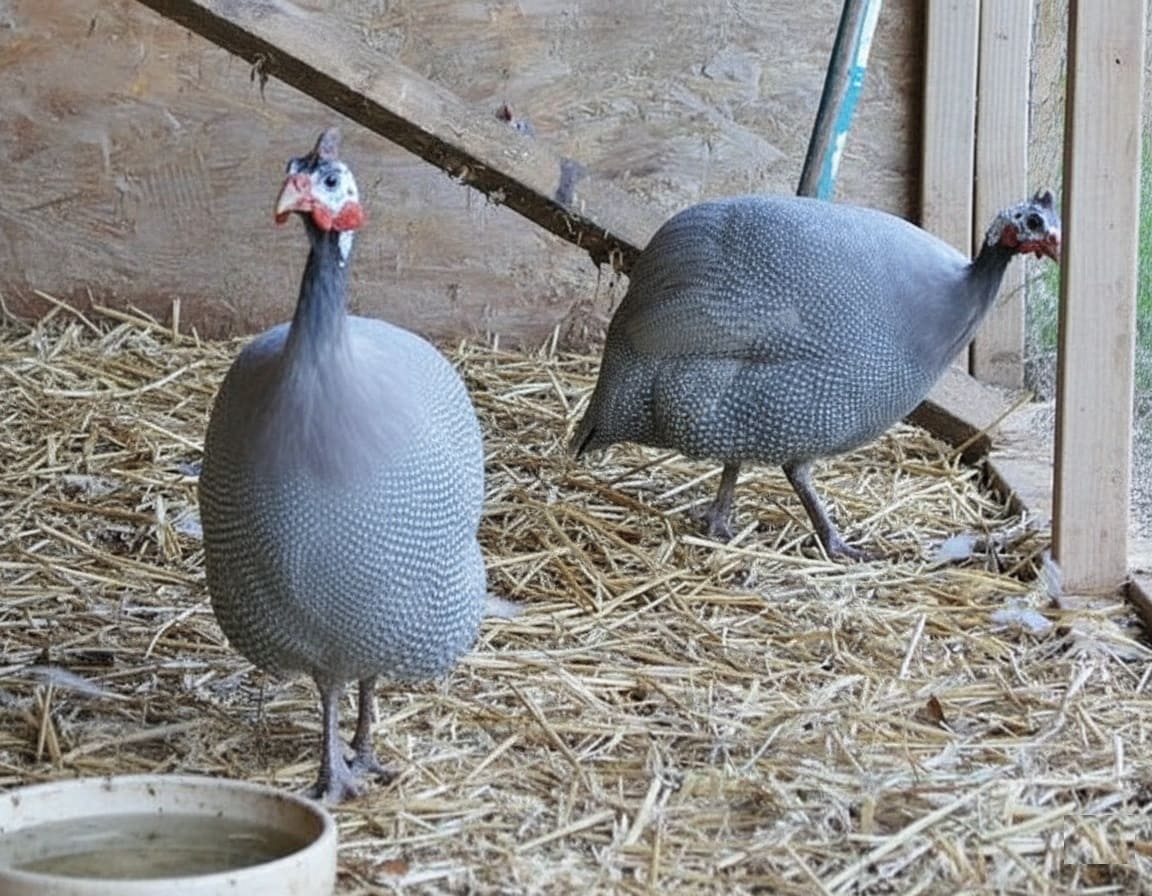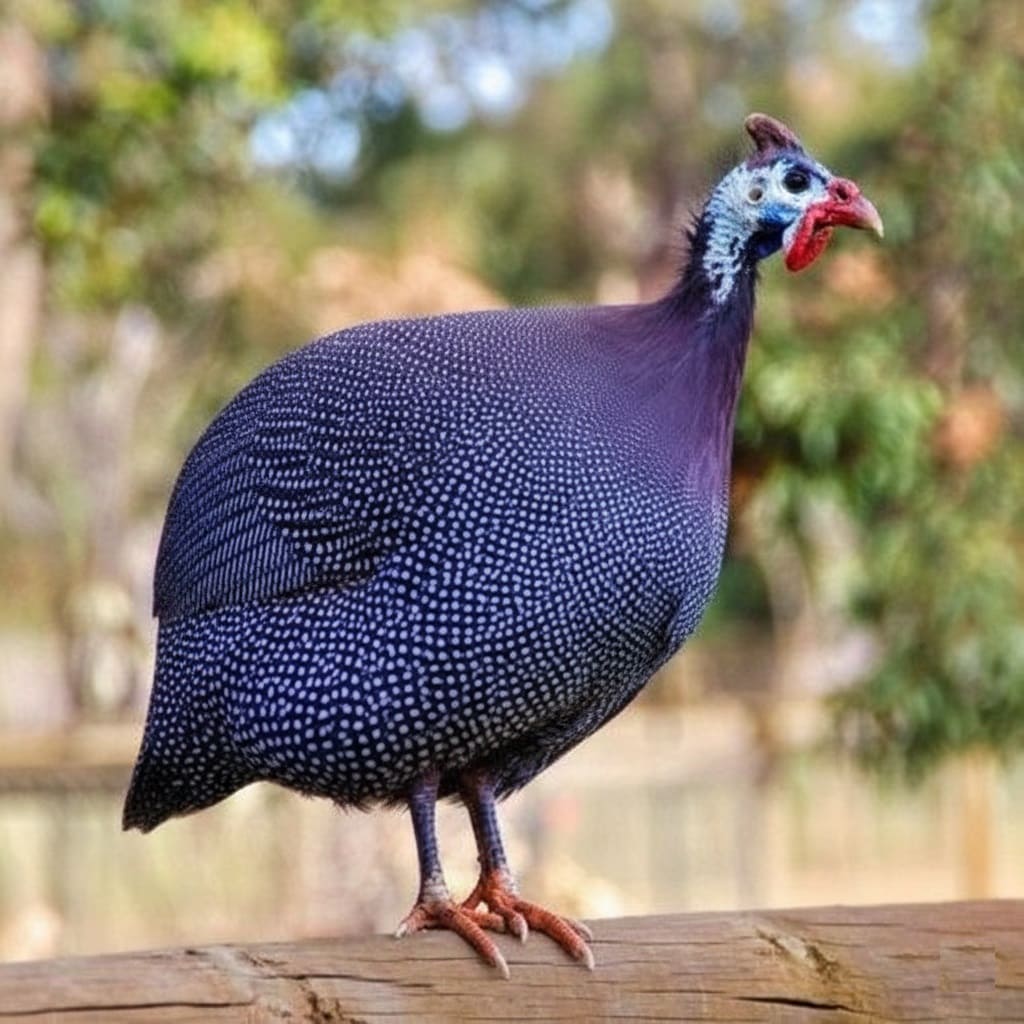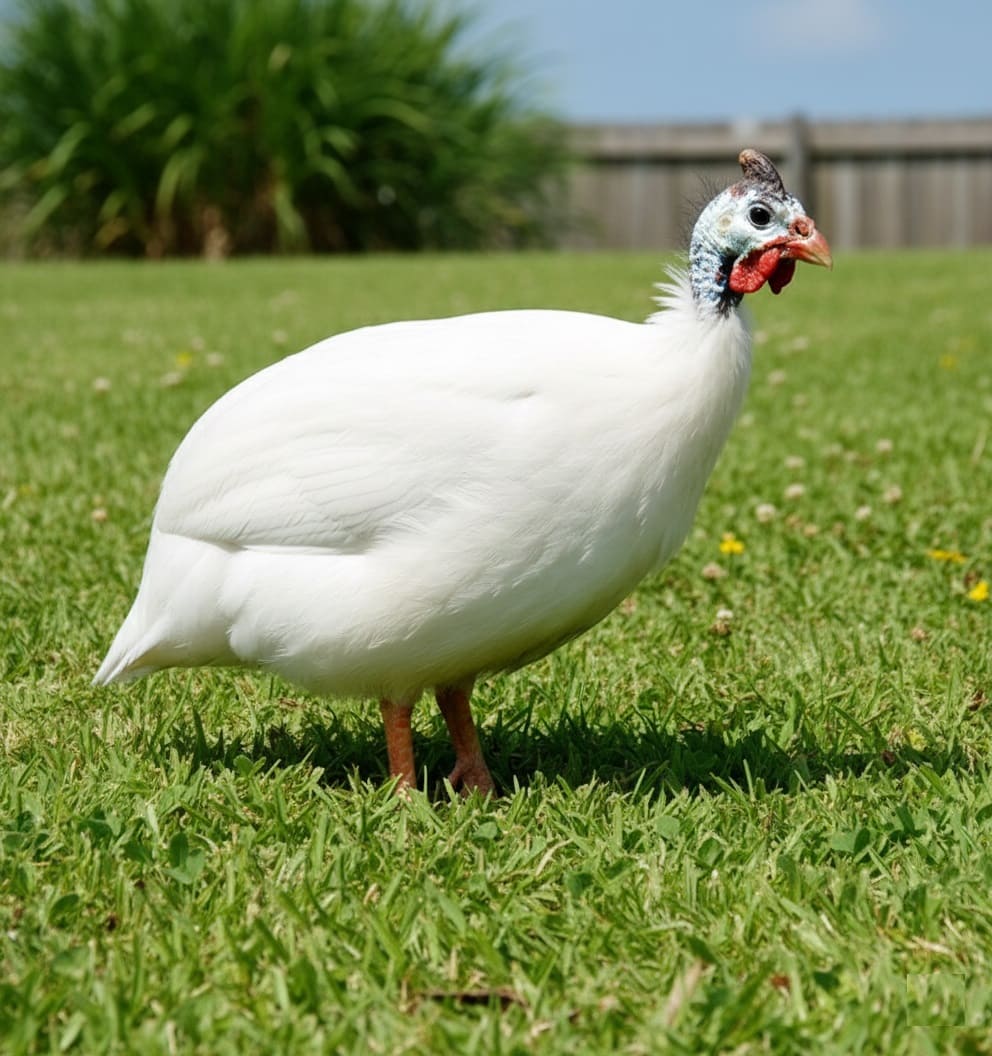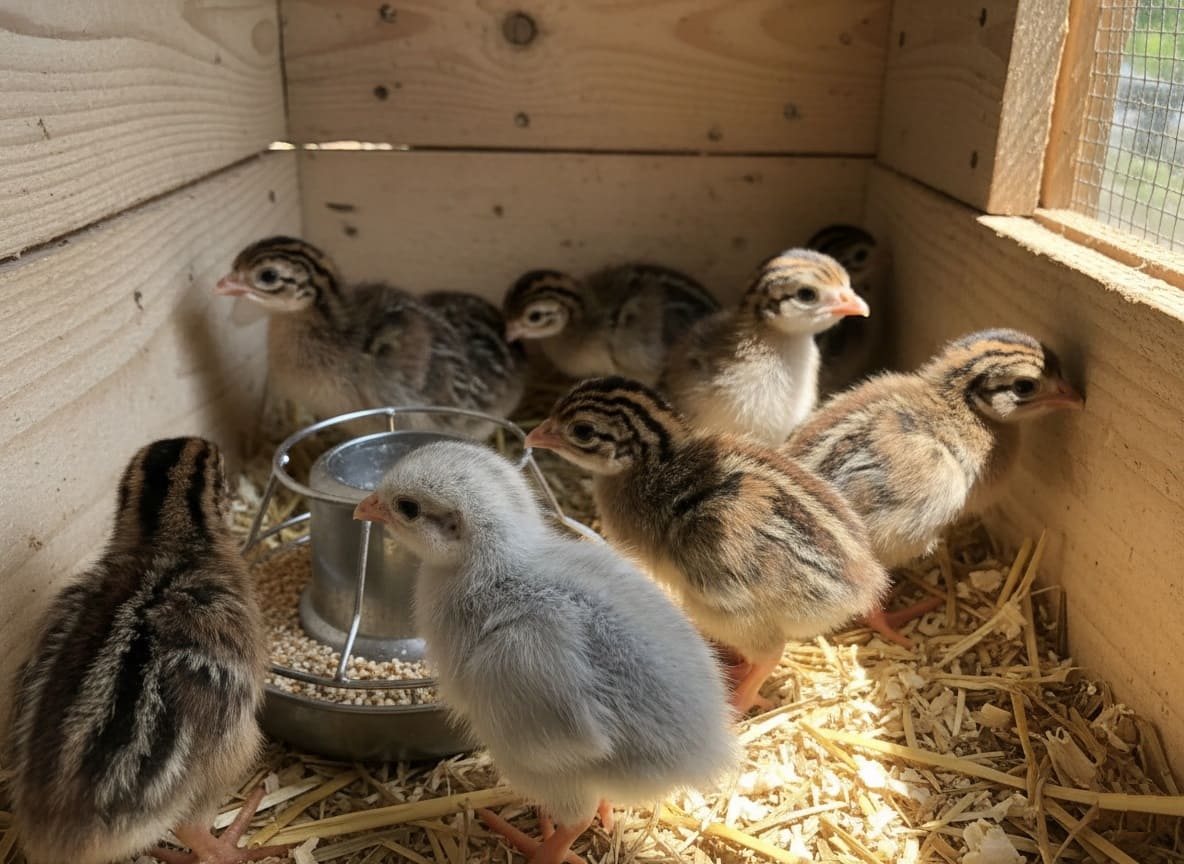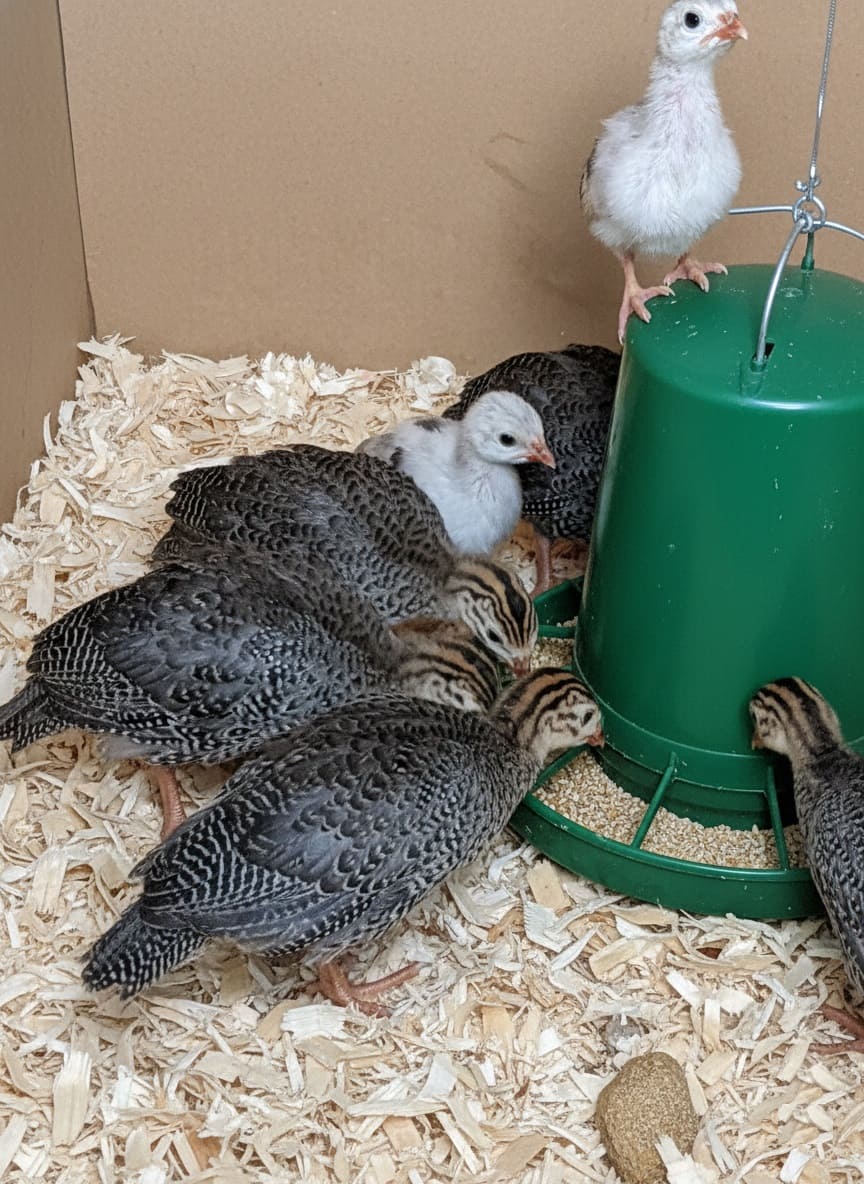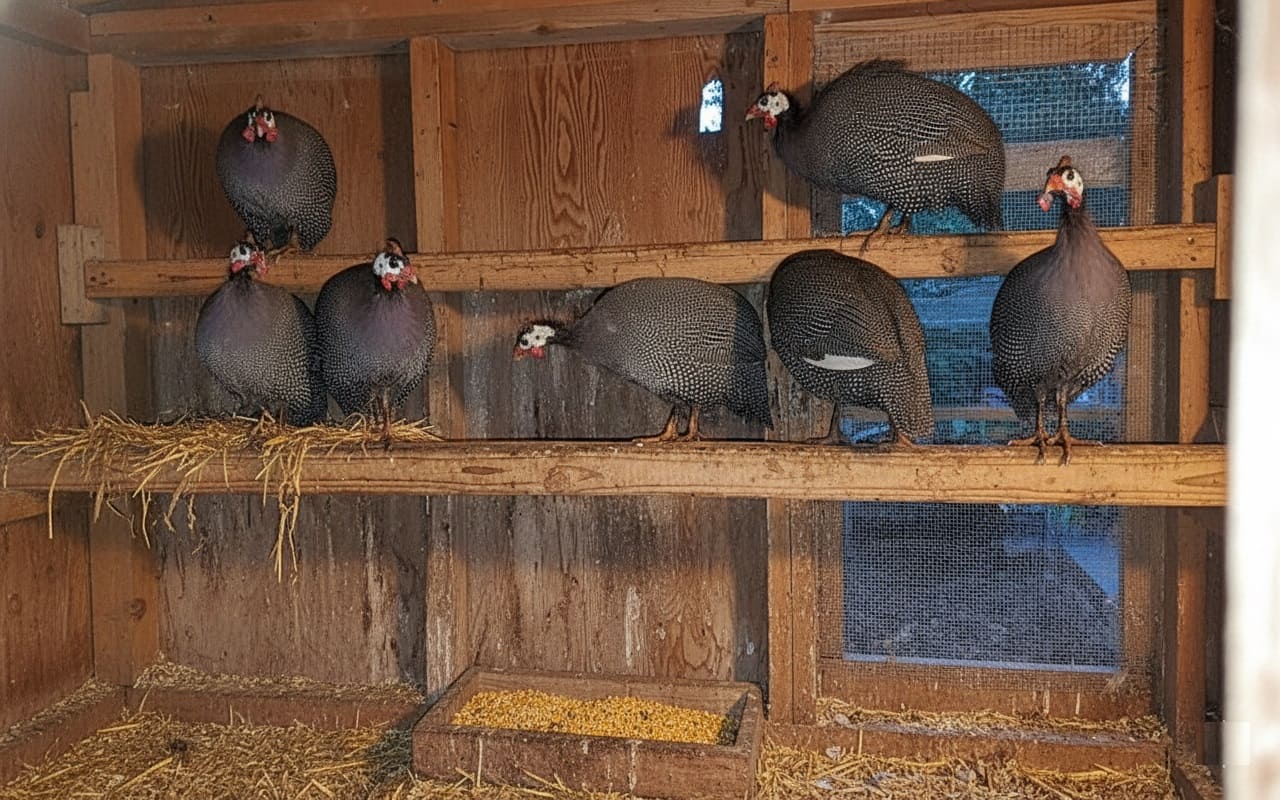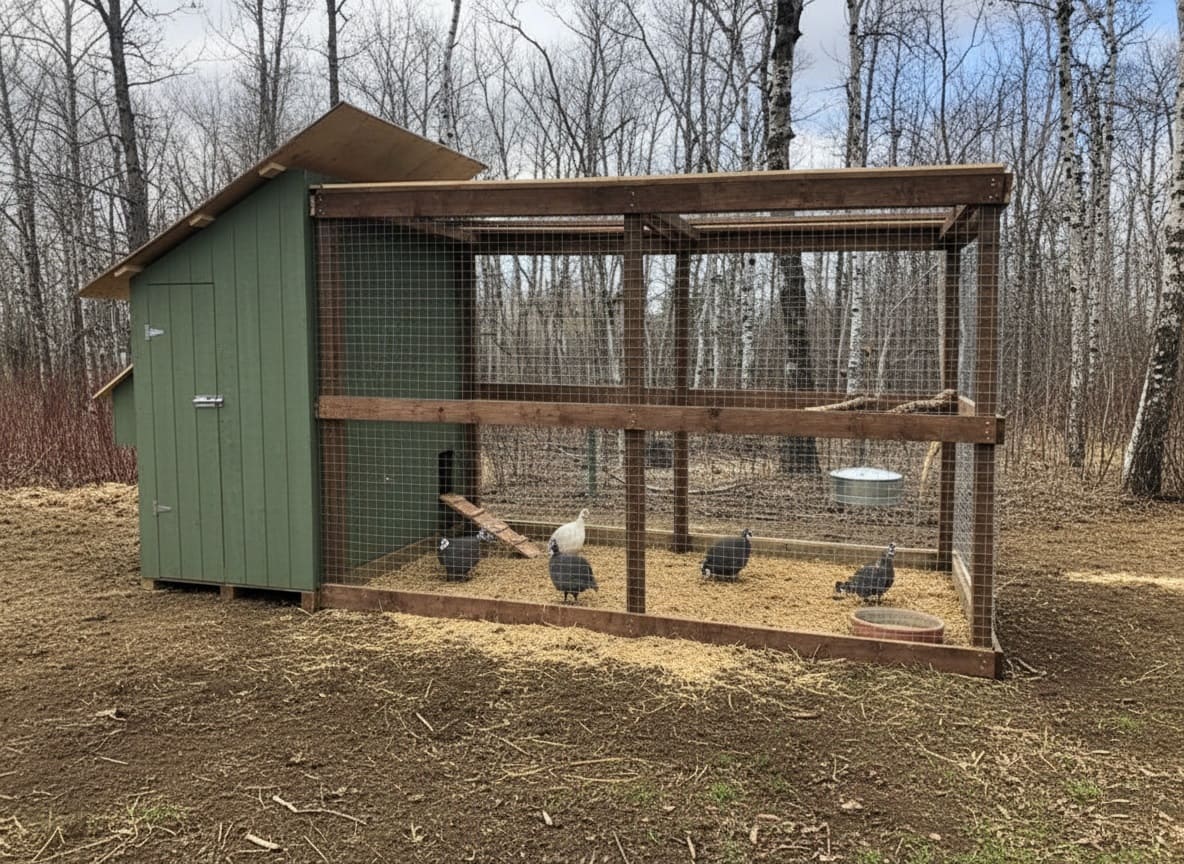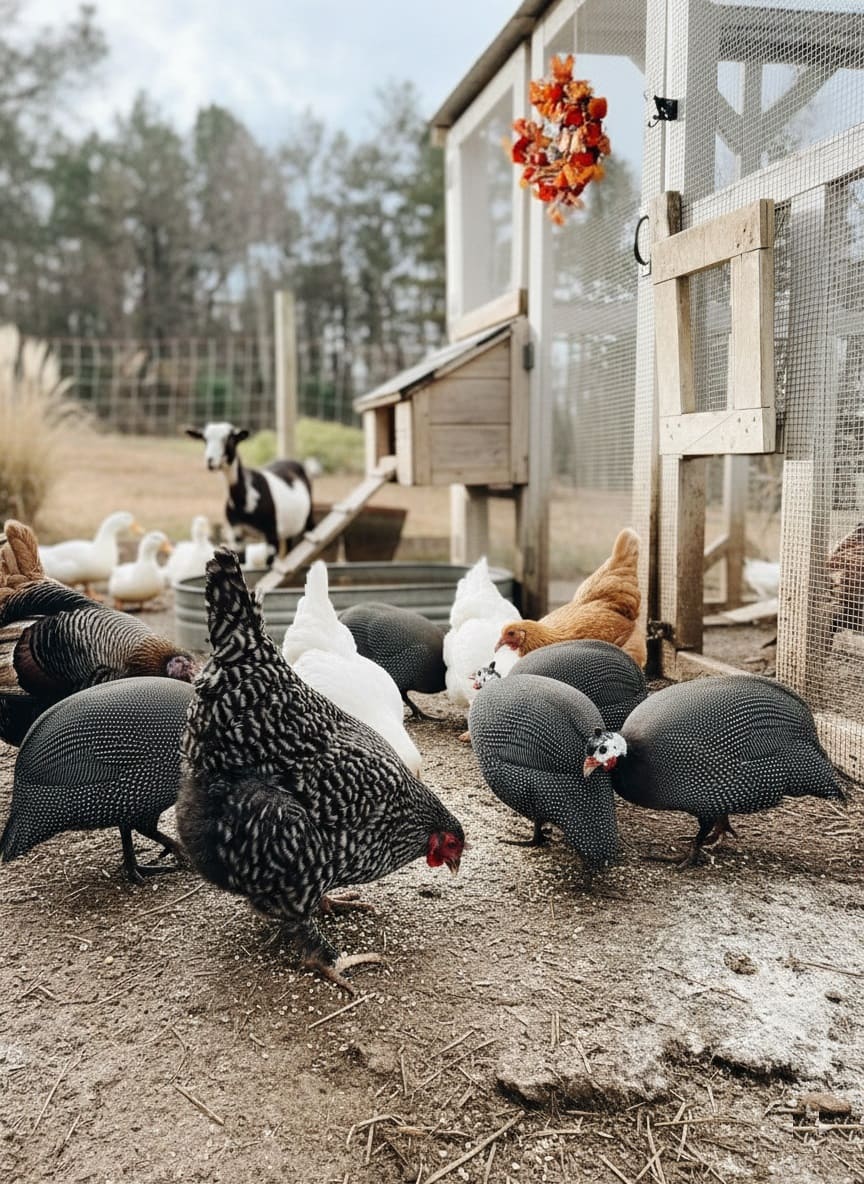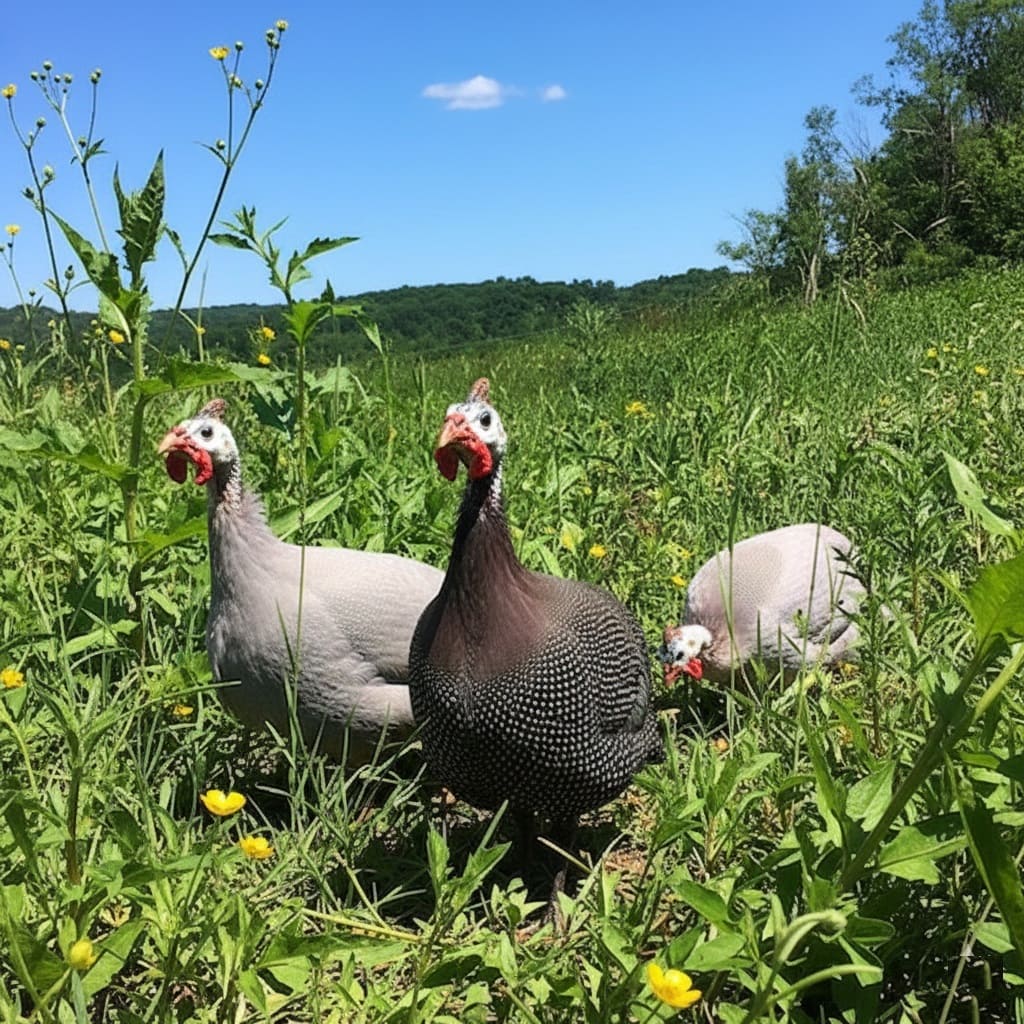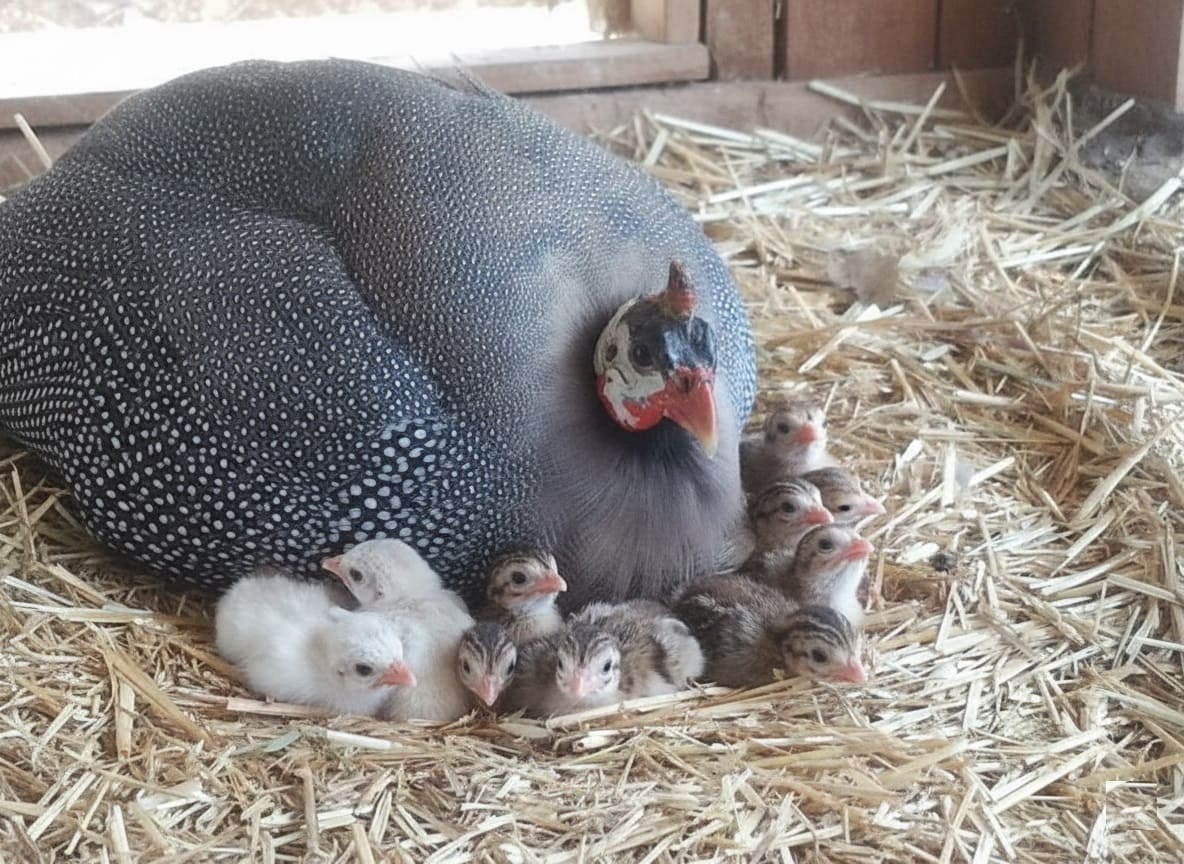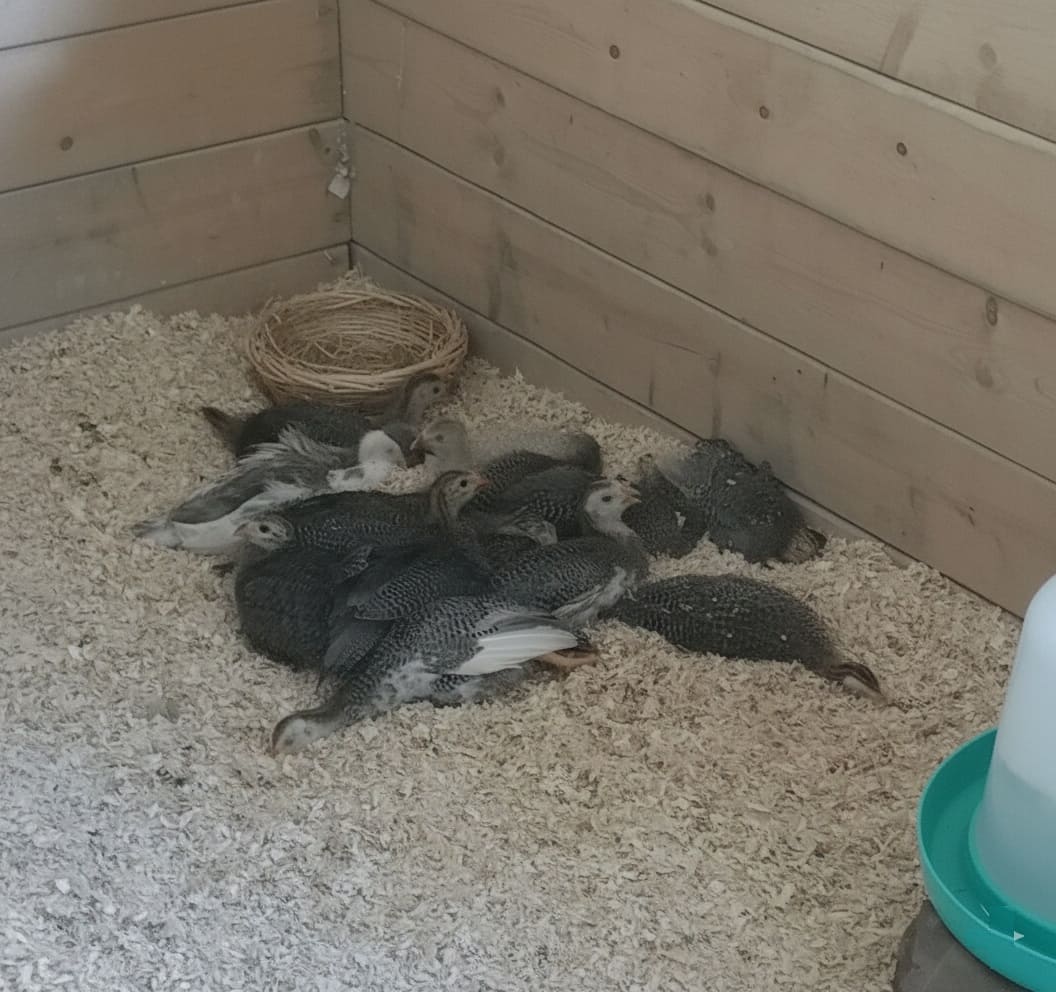Have you ever watched a flock of spotted birds march across your property like a tiny security patrol, devouring every tick and bug in sight? That’s the magic of guinea fowl.
These quirky, polka-dotted birds aren’t your typical backyard poultry—they’re alarm systems, pest eliminators, and entertainment rolled into one noisy package.
While they might test your patience with their vocal nature, guinea fowl offer benefits that make them worth every decibel.
Whether you’re battling a tick problem, looking for low-maintenance livestock, or simply want to add character to your homestead, this guide will walk you through everything you need to know about raising guinea fowl successfully.
By the end, you’ll understand how to care for these independent birds from day one, set up proper housing, manage their unique behaviors, and turn them into valuable members of your farm team.
Why Raise Guinea Fowl? The Benefits That Matter
Guinea fowl aren’t just decorative birds with fancy feathers—they serve real, practical purposes that can transform your property management approach.
Nature’s Pest Control Team
The primary reason most people introduce guinea fowl to their land is pest control, and these birds excel at this job with remarkable efficiency. A single guinea can consume thousands of ticks, grasshoppers, and other insects in a season.
Unlike chickens who scratch and destroy your garden beds, guineas delicately pluck pests from plants without damaging the foliage. They target Japanese beetles, stink bugs, locusts, and even small rodents, making them invaluable during growing season.
I remember the first summer after we brought guineas onto our property. We’d been battling a severe tick problem—you couldn’t walk through the tall grass without picking up a dozen of them.
Within three months of releasing our guinea flock, the tick population had dropped dramatically. Now, years later, we rarely find ticks on ourselves or our dogs, even during peak season.
Low-Maintenance Livestock
If you’re tired of high-maintenance animals that demand constant attention, guineas offer a refreshing change. These birds are remarkably self-sufficient when given adequate space to roam.
They forage for most of their nutritional needs, meaning lower feed costs for you. They’re also incredibly hardy—resistant to many diseases that plague chickens, and able to withstand cold temperatures better than most poultry.
Once established, a guinea flock essentially manages itself, requiring only basic shelter, supplemental feed during winter, and access to water.
Your Property’s Alarm System
Guineas possess an uncanny ability to detect anything unusual on your property. A strange vehicle, an unfamiliar person, a prowling predator—nothing escapes their notice or their vocal announcement.
While this constant chatter can be challenging (more on managing that later), it provides genuine security benefits.
Many homesteaders report that their guineas alert them to approaching visitors before any dog notices, and the birds’ aggressive mobbing behavior toward snakes has saved more than one farmer from an unwelcome encounter.
👉 Here’s How to Identify Shed Snakeskin: Understanding Snake Behavior in Your Yard
Additional Perks Worth Mentioning
Beyond the main benefits, guineas offer bonus advantages.
- Their eggs, though smaller than chicken eggs, are nutritious and rich in flavor—perfect for baking or cooking. The meat, while gamier than chicken, is prized by many for its distinct taste.
- Some homesteaders find success selling keets or hatching eggs to others looking to start flocks, creating a modest side income.
- And let’s not forget the entertainment value—watching guineas interact is endlessly amusing, from their group dynamics to their hilarious reactions to everyday occurrences.
Understanding Guinea Fowl Behavior: What Makes Them Unique
Before you bring guineas home, understanding their distinct personality traits will help you set realistic expectations and avoid frustration.
The Flock Mentality
Guineas are intensely social creatures who operate as a collective unit. They travel together, forage together, and make decisions as a group. This flock mentality is both their strength and their challenge.
A lone guinea is a stressed guinea—these birds genuinely need companionship from their own kind to thrive. This is why experts recommend starting with at least six birds, though eight to ten provides a more stable flock dynamic.
The flip side of this tight bonding is their tendency to form cliques and hierarchies. Introducing new birds to an established flock can be difficult, as guineas are notoriously unwelcoming to outsiders.
They’ll chase, peck, and exclude newcomers for weeks or even months. The most successful integration happens when birds are raised together from the keet stage.
Intelligence and Memory
Don’t underestimate guinea intelligence. These birds possess remarkable memory and learn quickly through observation and experience.
They remember their territory boundaries, recognize individual humans and animals, and develop consistent routines. Once they establish their home base, they’ll reliably return to it each evening—a crucial behavior for their safety.
However, this intelligence comes with a stubborn streak. Guineas resist training and domestication in ways that chickens readily accept. You can’t truly tame a guinea fowl; the best you can achieve is tolerance and routine-based cooperation.
They’ll never be lap birds seeking affection, but they will learn to associate you with food and become more comfortable with your presence over time.
Vocal Nature and Communication
Let’s address the elephant in the room—or rather, the loudest bird in the yard. Guineas are noisy. Extremely noisy. Their calls can reach surprising volumes, especially their distinctive alarm call that sounds remarkably like someone yelling “Buckwheat! Buckwheat!”
The females produce a two-syllable call that sounds like “come back, come back,” while males make single-syllable sounds.
This vocalization serves important purposes in the wild, helping flocks stay connected and warning of danger. On a homestead, it means your neighbors will definitely know you have guineas. Some calls occur throughout the day as birds communicate location and status.
The intensity and frequency increase when they spot anything unusual—which, to a guinea, includes mail carriers, butterflies, falling leaves, and their own shadows.
Managing this noise requires strategic thinking. Keeping guineas well-fed and content reduces unnecessary calling. Avoiding situations that stress the flock helps minimize alarm calls.
Most importantly, check local noise ordinances and talk with neighbors before bringing guineas home, especially in suburban or semi-rural settings.
👉 Understanding Rooster Crows: More Than Just a Morning Alarm
Roaming and Free-Ranging Behavior
Guineas are natural wanderers with strong urges to explore. Given the opportunity, they’ll range far from home base—sometimes several hundred yards or more.
This extensive roaming is excellent for pest control coverage but presents challenges for keeping them on your property.
Unlike chickens who rarely venture far from their coop, guineas will cheerfully march onto neighbors’ land, down roads, or into areas where they’re unwelcome.
The key to managing their roaming instinct lies in proper training during their early months. Birds that imprint on your property as home will reliably return, even after a day of wide-ranging adventures.
Rushed releases or inadequate acclimation time often result in guineas that disappear, never to return.
Choosing Your Guinea Fowl: Breeds and Varieties
While all guinea fowl share similar characteristics, several color varieties exist, each with subtle differences in temperament and appearance.
Pearl Gray Guineas
The most common variety in North America, Pearl Grays feature the classic polka-dot pattern that makes guineas instantly recognizable. Their feathers display intricate combinations of tan, black, brown, and white spots.
These birds tend to be slightly less high-strung than some other varieties, making them a good choice for beginners. The widespread availability of Pearl Grays also means you’ll find more resources and support specific to this variety.
Lavender Guineas
Available in both standard and jumbo sizes, Lavender guineas showcase beautiful blue-tinted plumage with white spots and stripes. The jumbo variety produces slightly larger birds, which some prefer for meat production, while standard lavenders are more compact.
Both types feature the characteristic spotted pattern but with a softer, more muted color palette than Pearl Grays. Their beaks and legs often display orange and blue coloring.
Coral Blue and Royal Purple Varieties
These less common varieties feature striking blue coloration ranging from light aqua to deep purple-blue.
Coral Blues display both light and dark blue striping on their feathers and often have blue-tinted beaks and legs.
The rare Slate variety presents as a solid purple-blue color without the typical guinea stripes, making them unique among guinea varieties.
White Guineas
Pure white guineas exist but are quite rare. They lack the camouflage advantage of spotted varieties, making them more vulnerable to predators.
Some farmers keep a few white birds in mixed flocks for visual variety, but most practical guinea keepers stick with spotted varieties for their better survival rates.
Which Variety Should You Choose?
For most homesteaders, Pearl Grays offer the best combination of availability, hardiness, and affordability. They’re easier to source locally or through hatcheries, and their well-established popularity means plenty of breeding stock exists.
If you’re specifically interested in a particular color for aesthetic reasons or breeding purposes, specialty varieties can be worth the extra cost and effort to locate—just expect to pay premium prices and potentially wait for availability.
Starting with Keets: Baby Guinea Care
Raising guinea fowl from the keet stage offers significant advantages. Young birds imprint on their environment, making them more likely to stay on your property and return to their coop reliably. Here’s how to give keets the best start.
Sourcing Your Keets
You have several options for obtaining baby guineas. Local hatcheries often carry keets during spring and early summer, allowing you to pick up birds without shipping stress.
Mail-order hatcheries ship day-old keets directly to your post office, though this method carries higher mortality risk due to shipping stress and temperature fluctuations.
Farm supply stores sometimes stock keets seasonally, though selection may be limited. Local breeders offer another source, often providing hardier birds already acclimated to your regional climate.
Regardless of source, buy more keets than you ultimately need. Guinea mortality rates during the first eight weeks are notably higher than with chickens.
Order at least twenty-five percent more birds than your target flock size. If you want a flock of twelve adult guineas, start with fifteen to sixteen keets.
👉 Read the Ultimate Guide to Welcoming Baby Chicks: Setup, Care & Tips for First-Timers
Setting Up the Brooder
Keets require a warm, safe environment for their first several weeks of life. A large plastic storage tote, stock tank, or dedicated brooding box works well for small numbers.
For larger batches, section off part of a garage, barn, or shed. The space needs to be draft-free, dry, and predator-proof.
Bedding choice matters significantly with keets. Pine shavings work well once keets are a few days old and recognize their food. However, for the first few days, paper towels provide the safest surface, preventing keets from eating bedding instead of their feed.
Avoid cedar shavings, which can cause respiratory issues. Change bedding frequently to prevent moisture buildup, as dampness is deadly for young guineas.
Temperature control is critical. Start keets at ninety-five degrees under the brooder heat lamp for their first week. Each week thereafter, reduce temperature by five degrees until reaching room temperature or outdoor conditions.
Watch the keets’ behavior—if they huddle tightly under the lamp, they’re too cold. If they disperse to the brooder edges, panting, they’re too hot. Comfortable keets spread throughout the brooder with some resting near the heat source and others exploring.
Feeding Keets Properly
Nutrition during the early weeks sets the foundation for healthy adult birds. Start keets on non-medicated chick starter with at least twenty-four to twenty-eight percent protein.
Game bird starter offers ideal protein levels for guineas. Never use medicated feed unless you have a specific disease concern—the medication can harm keets.
Provide feed in shallow dishes initially, switching to chick feeders as birds grow. Keets need constant feed access for the first several weeks. Some sources recommend tapping your finger in the feed when first introducing keets to their brooder, helping them identify food.
Water deserves special attention. Keets can drown in deep water containers, so use chick waterers with narrow channels or place marbles in shallow dishes to prevent drowning while allowing drinking.
For the first week, offer lukewarm rather than cold water—cold water can shock their delicate systems.
Adding three tablespoons of sugar per quart of water for the first few days provides an energy boost that helps keets thrive. Clean and refill waterers at least twice daily.
👉 Find out: Can Chickens Eat Bird Seed? Unraveling Myths and Facts
Supporting Keet Health
Young guineas benefit from natural immune support. Add a pinch of cinnamon and a pinch of oregano to their feed or water three times weekly. These herbs support respiratory and immune system health while adding flavors guineas enjoy.
Dried calendula flowers offer additional immune and circulatory benefits when sprinkled on feed weekly.
Watch for common keet problems. The dreaded “cuddle puddle” occurs when keets pile together for warmth, sometimes suffocating birds at the bottom.
While providing multiple warm spots helps, determined keets will still choose one pile location. This reality reinforces the importance of starting with extra birds.
Pasty butt—fecal material stuck to the vent area—requires immediate attention. Gently clean the area with warm water to prevent blockage.
Introducing Treats
Wait until keets reach at least two weeks old before offering any treats. Even then, treats should constitute less than ten percent of their diet.
Lettuce makes an excellent first treat, encouraging natural foraging behavior. Tear it into small pieces and watch the entertainment unfold as keets chase each other for the best bits.
Grapes, cut into tiny portions, are guinea favorites—they’ll run around with grape pieces like miniature football players. Keep fruit treats minimal to prevent digestive upset.
👉 Find out: Can Chickens Eat Sunflower Seeds? Everything You Need to Know
Transitioning to Outdoor Living
Moving guineas from the brooder to outdoor housing requires patience and proper timing. This transition period determines whether your birds become reliable returners or wandering nomads.
When to Move Outdoors
Keets need six to eight weeks in the brooder before transitioning outside, though timing depends heavily on weather conditions. Spring and summer hatches can move outside sooner than fall or winter hatchlings.
The birds should be fully feathered before facing outdoor temperatures. Watch nighttime lows especially—even spring evenings can chill partially feathered birds.
Acclimation Process
The biggest mistake new guinea keepers make is rushing the outdoor transition. Success requires gradually acclimating birds to their new environment while building strong home base associations.
Move the brooder outside but keep it covered and protected for several days, letting birds hear and see the outdoor world while remaining safe.
Next, place an outdoor brooder or grow-out pen immediately adjacent to where you want birds to eventually roost—typically near or attached to your chicken coop.
Transfer the keets to this space and keep them confined for six to eight weeks minimum. This extended confinement frustrates many beginners who want to see their guineas roaming, but it’s absolutely essential for imprinting the location as home.
During this confinement period, guineas should see and hear their permanent roosting structure constantly. If planning to have guineas roost with chickens, place the grow-out pen directly against the chicken coop run.
Hang a solar light inside the coop to help guineas overcome their fear of dark spaces—they’re naturally hesitant about enclosed, dim areas.
First Release
When you finally open the outdoor brooder door, resist the urge to force birds out. Simply open the access and let guineas venture out at their own pace.
Some may exit immediately, others might take hours. This self-directed exploration helps them maintain awareness of their safe space.
For the first several weeks of free-ranging, supervise releases. Let birds out in early afternoon rather than morning, giving them a few hours to explore before natural roosting time draws them back.
Consistently call them for special treats before releasing them, building positive associations with your voice and presence.
Housing and Infrastructure
While guineas are less demanding than chickens regarding shelter, they still need basic infrastructure that accommodates their unique nature.
Roosting Preferences
In the wild, guineas roost in trees at night for protection from ground predators. This instinct translates to strong preferences for elevated roosting bars in captivity. They’ll choose the highest available perch every time.
Roosts should be sturdy—thick branches or two-by-fours set at varying heights work well. Position roosts high enough that birds feel secure, typically four to six feet off the ground.
Guinea droppings accumulate directly under roosting areas, so consider this when planning coop layout. Using droppings boards or positioning roosts over easy-to-clean areas saves maintenance effort.
Coop Design Considerations
If housing guineas separately from chickens, the coop can be simpler than traditional chicken housing. Guineas don’t need nesting boxes inside the coop—they’ll lay eggs wherever they please outdoors during breeding season.
The primary function of guinea housing is providing a safe place to roost at night, sheltered from weather and predators.
Adequate ventilation is crucial. Guineas tolerate cold better than heat, and they produce significant moisture through respiration and droppings.
Proper airflow prevents respiratory issues and moisture accumulation. Position vents near the roof to allow warm, moist air to escape while preventing direct drafts on roosting birds.
Space requirements are less stringent than for chickens since guineas spend most daytime hours outdoors.
However, cramped conditions stress the flock and can trigger aggressive behaviors. Aim for at least four square feet of floor space per bird as an absolute minimum, with more being better.
Predator Protection
This cannot be overstated—use hardware cloth, not chicken wire, for any opening in guinea housing. Chicken wire keeps birds in but does nothing to keep predators out.
Raccoons, minks, weasels, and other predators easily reach through chicken wire to grab and kill birds. Hardware cloth with quarter-inch or half-inch mesh provides genuine protection.
Learning this lesson cost me dearly during my first year with guineas. I’d built what I thought was a secure brooder covered in chicken wire, elevated on barrels to prevent digging predators.
One morning I discovered the carnage—a mink had climbed the adjacent run fencing, reached through the chicken wire, and killed multiple birds by holding them against the barrier.
The mink couldn’t get the bodies out but had time to partially consume several guineas through the wire.
I imagine successive guineas ran over to defend their flockmates, only to become victims themselves. Now I use exclusively hardware cloth for any poultry housing, despite the higher cost.
Secure the coop floor against burrowing predators if your coop sits on bare ground. Bury hardware cloth at least twelve inches around the perimeter, or pour a concrete floor. Check for gaps or holes regularly—predators are persistent and creative.
Integration with Chickens
Many homesteaders successfully house guineas with chickens, though this arrangement requires some management. The species generally coexist peacefully once everyone establishes the pecking order.
However, young guineas may be bullied by adult chickens, especially roosters, so introduce birds of similar ages when possible.
Guineas and chickens can share feeders and waterers, though guineas may dominate access.
Their dietary needs differ slightly—guineas require higher protein than laying hens—so provide game bird feed if exclusively feeding guineas, or offer supplemental protein sources when housing mixed flocks.
The main integration challenge is getting guineas comfortable entering the coop at night. Remember their aversion to dark spaces. Hang lights inside the coop and leave them on initially.
Enter the coop yourself during early evening and let guineas see you inside without fear. Once a few brave guineas start using the coop, others follow the flock mentality.
Managing Free-Range Guineas
Once acclimated and released, free-range guineas require ongoing management to keep them safe, productive, and preferably on your property.
Establishing Territory
Guineas naturally patrol and defend their territory once established. This territorial behavior provides the pest control and alarm system benefits you want, but the territory must be properly defined.
During the first several months of free-ranging, guineas gradually expand their range. The birds establish mental boundaries through repeated exploration and routine.
You can influence territory size by where you release birds and how you reward returns. Birds that range too far and find nothing interesting will gradually reduce their wandering radius.
Conversely, neighbors who feed your guineas will unknowingly encourage increased roaming—one reason to give neighbors fair warning before getting guineas and asking them not to provide supplemental feed.
Daily Routines
Guineas thrive on routine. They’ll develop consistent daily patterns—leaving the roost at dawn, foraging specific areas at certain times, taking midday rests in shaded spots, and returning to roost at dusk.
Supporting these natural rhythms by providing feed and treats at consistent times reinforces their schedule and ensures regular return to home base.
Calling your flock with a distinct sound at feeding time creates a recall mechanism. While guineas won’t come running like dogs, consistent call-treat associations mean they’ll head your direction when they hear your signal, especially if they’re already heading home for the evening.
This proved invaluable on multiple occasions when I needed to check on the flock or wanted them secured before approaching storms.
Seasonal Considerations
Winter changes guinea behavior and needs. While remarkably cold-hardy, guineas forage less during winter, especially in snow-covered areas where insects are unavailable.
Increase supplemental feeding during cold months to maintain body condition. Provide access to unfrozen water multiple times daily—dehydration is as dangerous as cold temperatures.
Summer brings breeding season, which dramatically alters hen behavior. Nesting hens become secretive and may disappear for hours or days.
Males become more vocal and potentially aggressive toward each other. Understanding these seasonal shifts prevents unnecessary worry.
Addressing Roaming Problems
If guineas consistently roam too far or visit neighbors’ properties, several strategies can help. Confine the flock for several days to reset their ranging behavior.
Increase the attractiveness of your property by planting guinea-friendly vegetation or maintaining areas with good insect populations. Remove temptations from neighboring properties if possible—talk to neighbors about not feeding stray guineas.
In extreme cases, wing clipping reduces flight ability and restricts range, though this is considered a last resort by most keepers since flight is crucial for predator evasion.
Feeding Your Guinea Flock
Despite being excellent foragers, guineas need supplemental nutrition, especially during certain life stages and seasons.
Nutritional Requirements by Age
Keets require twenty-four to twenty-eight percent protein in their starter feed. This high protein content supports their rapid growth and development.
Transition to juvenile feed with twenty percent protein around eight to ten weeks of age. By six months, guineas can eat adult feed with sixteen percent protein.
Game bird feed formulated for guineas and similar species often provides better nutrition than standard chicken feed, though it typically costs more.
If game bird feed isn’t available or affordable, high-quality chicken feed supplemented with additional protein sources works adequately.
👉 Read the Ultimate Guide to Feeding Your Backyard Laying Hens for Maximum Egg Production
Free-Range Foraging
During spring, summer, and fall, free-range guineas obtain the majority of their nutrition from foraging. They consume enormous quantities of insects, ticks, spiders, and other pests.
They’ll also eat seeds, some vegetation, and occasionally small reptiles or rodents. This natural diet provides the protein and nutrients they need while reducing your feed costs significantly.
However, don’t assume free-range guineas need no supplemental feed. Providing consistent daily feed ensures adequate nutrition even when foraging conditions are poor due to weather or season. It also reinforces their habit of returning home daily.
Winter and Confined Feeding
Birds kept in confinement or those living through harsh winters with limited foraging need their full nutritional requirements met through supplemental feed.
Increase protein slightly during winter months—raising it to eighteen or twenty percent helps birds maintain body condition when they’re burning more calories for warmth.
Offer feed free-choice in covered feeders that protect from weather. Guinea feed consumption increases during cold weather, so check and refill feeders more frequently in winter.
Prevent feed from freezing or becoming wet, which makes it unpalatable and can cause health issues.
👉 Learn about Winter Care for Chickens: Tips to Keep Your Flock Healthy & Happy
Water Access
Fresh water availability is non-negotiable year-round. Guineas drink more than chickens and need constant access to clean water.
Position waterers in shaded areas during summer to keep water cool. In winter, use heated waterers or replace frozen water multiple times daily.
Breeding and Raising Guinea Chicks Naturally
If you plan to breed guineas and let hens raise their own keets, understanding their reproductive behavior helps maximize success.
Mating Behavior
Guinea mating season typically begins in spring as temperatures warm and daylight lengthens. Males become increasingly interested in hens, and you’ll notice more displays and vocalizations.
Male guineas may become mildly aggressive toward each other during breeding season, engaging in posturing and occasional scuffles to establish dominance.
The mating process itself can appear violent to observers unfamiliar with guinea behavior. The male catches the hen and tugs on her back feathers until she submits. The actual mating is brief but intense.
If the hen escapes, the male will persistently pursue her—flying after her, chasing her into trees, and tracking her for an hour or more until he succeeds. This determined behavior is normal and doesn’t indicate a problem.
Guineas may form pairs or one male may keep a small harem of hens. Paired birds show strong bonds and exhibit anxiety when separated—this is when you’ll hear the distinctive “come back, come back” calls.
While guineas aren’t affectionate toward humans, they do show tenderness toward their mates.
Nesting and Egg Laying
Guinea hens are secretive nesters who prefer hidden locations far from human activity. They’ll choose spots under bushes, in tall grass, or within dense vegetation. Hens can lay clutches of ten to fifteen eggs, though losses to predators are common.
Once sitting begins, the male typically maintains constant patrol around the nest site, protecting his mate day and night. This devoted behavior is remarkable to observe, though approach carefully—normally docile males become defensive around nesting hens.
If a hen proves to be a poor sitter or is killed, collecting the eggs for artificial incubation is possible if discovered within ten days of laying and assuming they haven’t been exposed to temperature extremes.
Bantam hens are exceptional broody birds and will sometimes accept guinea eggs, though the smaller, more fragile guinea eggs may get crushed under their weight.
👉 Discover the Top Egg-Laying Chicken Breeds for Your Backyard Flock
Hatching and Keet Survival
Guinea eggs incubate for twenty-six to twenty-eight days. Maintain incubator temperatures between ninety-five and one hundred degrees for successful hatching. If using an incubator, follow standard procedures for humidity and turning.
Mother-raised keets face significantly higher mortality than brooder-raised ones, but the trade-off is that surviving birds are exceptionally hardy and streetwise.
The hen teaches keets to forage, recognize danger, and survive in the wild. However, she struggles to defend the entire brood from predators, especially raptors.
If you want to maximize keet survival while allowing some natural raising, consider collecting eggs after the first week of laying and incubating them yourself, leaving just a few for the hen.
This gives her the satisfaction of hatching and raising some chicks while ensuring more babies survive overall.
Health and Common Problems
Guineas are notably hardy birds resistant to many chicken diseases, but they’re not invincible.
Disease Resistance
Compared to chickens, guineas experience fewer health problems. They’re more resistant to common poultry diseases like Marek’s disease and coccidiosis.
Their active foraging lifestyle and preference for roosting high off the ground reduces parasite exposure. Many long-time guinea keepers report never treating their flocks for health issues.
Vulnerability to Dampness
The greatest environmental health threat to guineas is dampness. These birds evolved in dry African climates and struggle in wet conditions. Wet feathers lose insulating properties, leading to chilling. Damp living conditions promote respiratory infections and parasites.
Always provide covered areas where guineas can escape rain and snow, and maintain dry bedding in roosting areas.
Predation
By far the biggest threat to guineas is predators, not disease. Hawks, owls, foxes, coyotes, raccoons, dogs, and many other predators view guineas as food.
The birds’ ground-dwelling nature despite their flight ability makes them vulnerable. Their mobbing behavior toward threats sometimes backfires when the threat is faster or more dangerous than expected.
Free-range guineas face constant predation pressure. Accept that you’ll lose some birds to predators no matter how vigilant you are.
Secure nighttime housing and teaching guineas to roost in safe locations greatly reduces losses, but daytime predation remains a risk of free-ranging.
The Squishing Problem
The tendency of guineas to pile together creates an unusual mortality issue, especially with younger birds. When guineas cuddle together in their “cuddle puddle,” birds at the bottom sometimes suffocate under the weight of those above.
This happens even when ample space exists and multiple sleeping areas are provided—guineas will still choose to pile in one corner.
Unfortunately, no perfect solution exists for preventing squishing. Providing adequate space, multiple small heated areas in brooders, and starting with extra birds helps mitigate the problem but doesn’t eliminate it entirely.
Legal and Neighbor Considerations
Before getting guineas, address the legal and social aspects of keeping noisy birds.
Local Regulations
Check your local zoning laws and homeowners association rules regarding poultry before purchasing guineas.
Some areas prohibit all poultry, while others allow chickens but not guineas specifically due to noise concerns. Rural areas rarely have restrictions, but suburban locations often do.
Some municipalities classify guineas differently than chickens, with separate regulations. Others lump all poultry together. Don’t assume that if chickens are allowed, guineas automatically are too. Verify regulations in writing to avoid later conflicts.
Neighbor Relations
Even in areas where guineas are legal, being a good neighbor matters. Guinea noise carries surprisingly far, especially during their frequent alarm calls.
Talk with nearby neighbors before getting birds, explaining what guineas are, why you want them, and what noise to expect. Many neighbors prove supportive, especially when you mention the tick control benefits.
Consider offering to let your guineas range onto neighbors’ properties if they’re interested in natural pest control.
Some neighbors appreciate having ticks and snakes reduced without maintaining their own birds. Others won’t want the noise or droppings. Respect their preferences.
If conflicts arise, work toward compromise. Perhaps confining birds until mid-morning reduces early noise. Increasing flock size might seem counterintuitive, but content flocks in sufficient numbers often settle down faster than small, anxious groups.
Advanced Tips for Success
After mastering the basics, these advanced strategies can elevate your guinea-keeping experience.
Breeding as a Side Business
Guinea chicks consistently sell well because demand outpaces supply in many areas. The difficulty of raising keets and breeding guineas in confinement means fewer people produce them compared to chickens. If you successfully breed guineas, you’ll likely find eager buyers.
Building a breeding operation requires more infrastructure than keeping a simple free-range flock. Construct large, tall runs that simulate free-range conditions to encourage mating and egg-laying.
Tall, spacious coops prevent stress that inhibits breeding. Collect eggs regularly for incubation rather than relying on natural hatching to maximize production.
Price guinea keets higher than chicken chicks—they’re harder to raise and more in demand. Straight-run (unsexed) keets typically sell for three to five dollars each, with higher prices for specialty colors or proven breeds.
Training for Property Boundaries
While you can’t train guineas like dogs, you can influence their behavior through consistent management. Walk property boundaries regularly with young birds following you during their first months of free-ranging.
They’ll mentally map these routes as part of their territory. Reward birds that stay within boundaries with special treats, and consistently guide wanderers back to your property.
Physical barriers like fencing don’t contain guineas well since they fly easily, but visual barriers like hedgerows or tree lines create psychological boundaries they’re less likely to cross.
Dealing with Nuisance Behaviors
Beyond noise, guineas occasionally develop problem behaviors. Hens laying eggs in inconvenient or dangerous locations can be redirected by blocking access to problem spots and providing attractive alternatives.
Birds that roost on vehicles or porch rails respond to deterrents like bird spikes or motion-activated sprinklers.
Guineas scratching in garden beds usually do less damage than chickens but can still be problematic. Temporary fencing during seedling stages protects vulnerable plants while allowing access once plants mature enough to withstand guinea activity.
Frequently Asked Questions
- How many guineas should I start with?
Start with at least six guineas, though eight to ten is better. This provides adequate flock size for their social needs while accounting for inevitable losses. Starting with more keets than your target flock size ensures you reach your goal despite typical mortality rates.
- Can I keep just one or two guineas with my chickens?
While technically possible, it’s not recommended. Lone guineas or very small groups experience significant stress from lacking proper flock companionship.
They’re more likely to wander seeking other guineas or become victims of bullying by chickens. If integrating species, maintain at least four to six guineas minimum.
- Will guineas kill snakes?
Guineas aggressively mob snakes and will kill small ones, but they don’t regularly consume them. Large snakes pose danger to guineas rather than the reverse.
The birds’ primary benefit regarding snakes is their alarm behavior, alerting you to snake presence and often driving the snake away through harassment.
- How long do guineas live?
Guineas can live ten to fifteen years in protected environments, though five to eight years is more typical for free-range birds.
Predation is the primary factor limiting lifespan—birds that avoid predators and receive good care often surprise their keepers by living many years.
- Do guineas return to the coop every night?
Properly trained guineas reliably return to roost at their home base each evening. However, this behavior requires adequate acclimation time during their first weeks on your property.
Rushed releases or insufficient confinement periods often result in birds that wander and fail to return consistently.
- Are guineas worth the effort?
For people dealing with serious tick or insect problems, living in rural areas where noise isn’t an issue, or who appreciate low-maintenance livestock, guineas are absolutely worthwhile.
They’re not for everyone, though. Urban or suburban homesteaders with close neighbors often find the noise challenges outweigh the benefits. Consider your specific situation and priorities when deciding.
Conclusion: Your Guinea-Keeping Journey
Key Takeaways:
- Start with at least 6-10 birds to establish a healthy flock dynamic
- Confine young guineas for 6-8 weeks minimum to properly imprint your property as home
- Use hardware cloth, not chicken wire, for all housing to protect against predators
- Expect significant noise and plan accordingly with neighbors and local regulations
- Free-range guineas provide excellent pest control while requiring minimal maintenance once established
- Weather extremes, especially dampness, pose the greatest health threat to guineas
Raising guinea fowl successfully comes down to understanding their unique needs and working with their natural instincts rather than against them.
These aren’t domesticated birds that crave human interaction—they’re semi-wild creatures that offer practical benefits when given appropriate space and freedom.
Set realistic expectations, prepare proper infrastructure before bringing birds home, and commit to the lengthy acclimation process that ensures your guineas stay on your property.
The reward for your patience is a self-sufficient flock that patrols your land, eliminates pests, and alerts you to anything unusual—all while requiring minimal daily input from you.
Every homestead has different needs and circumstances, but for the right situation, guinea fowl become invaluable team members that more than earn their keep.
Ready to start your guinea fowl adventure? Begin by talking with neighbors, checking local regulations, and planning your brooder and housing setup.
Order those keets for spring arrival, and prepare for the entertaining, occasionally frustrating, ultimately rewarding experience of keeping these uniquely useful birds. Your tick-free summer awaits!
